Hazrat Syed Abul-Fazl Jamal-ud-din Shah Muhammad Yusuf Gardez, the first-ever saint to set foot on the ruined planes of Multan. Yet honouring it with the title ‘City of Saints’. Soon, Multan became the portal of Sufi presence on the sphere, hosting saints within the subcontinent. Moreover, the final resting place of Shah Yusuf Gardez, commonly known as the Shrine of ‘Shah Gardez’ lies in the heart of crowded alleys of the city.
Yusuf Shah was born in 450AH in the district of Gardez in Afghanistan. However, the district now is known by the name Paktia Province of Afghanistan. The saint travelled to the city as his father Shah Ali Kasswer directed him. Henceforth, centuries later, his shrine is nestled at the same place, he first settled, with his children residing beside him. One of the largest clan of the city ‘The Gardezi Clan’ are known for their place of origin in Afghanistan. The area around the shrine is occupied by the family itself and goes by the name ‘Muhallah Shah Gardez’.
Muhallah Shah Gardez, The Walk & The View
The word muhallah in itself refers to a neighbourhood in the context of the Urdu language. Muhallah of a particular location can be the localities of that location. Illustrating the muhallah of the shrine it is all occupied by the same family members. Therefore in the muhallah of the shrine, the walk and the view are considered as spiritual as the shrine very own nature. A web weaved of such narrow lanes and turns, lands right in front of a rectangular blue-tiled view. Herein, rests the saint, the blue-tiled room lodges the grave of Shah Gardez.
As you walk down the narrow streets that hug the tall buildings at the sides, you feel a spiritual aura around it. Necessarily, it illustrates as something in the air calls you for peace and serenity. Unlike, fine black inked roads giving a mystical view, these cramped up, broken alleys are more about silence and tranquillity. While observing the roads, you see both ends covered will tall structures yet a beam of light mirrors the path. Just as historians and Sufism reflects, these alleys find light no matter how small and dark they are. Angling to some turns these confined alleys eventually find their destiny; The Blue-Tiled Rectangular View.
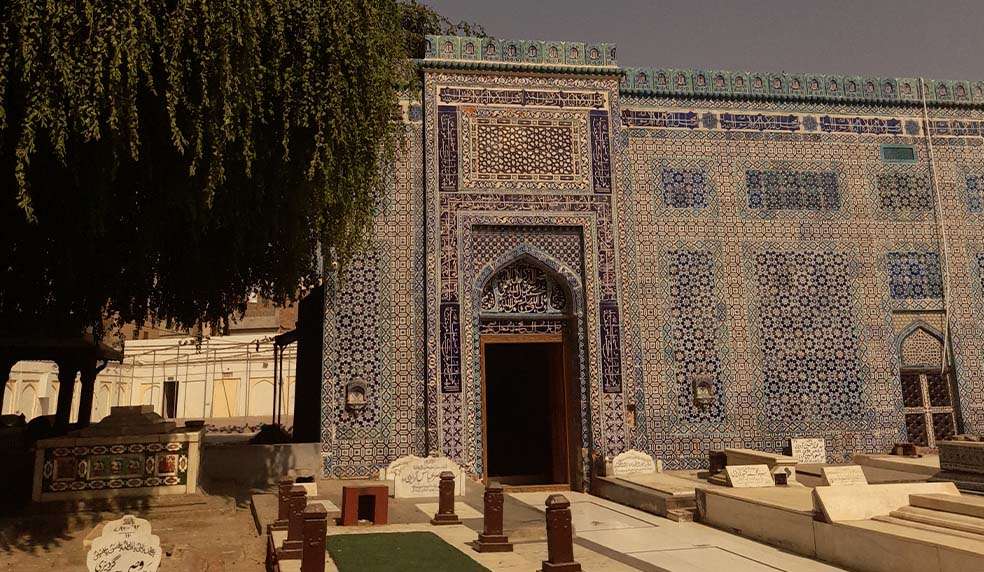
Photo Credits: Project Daastan
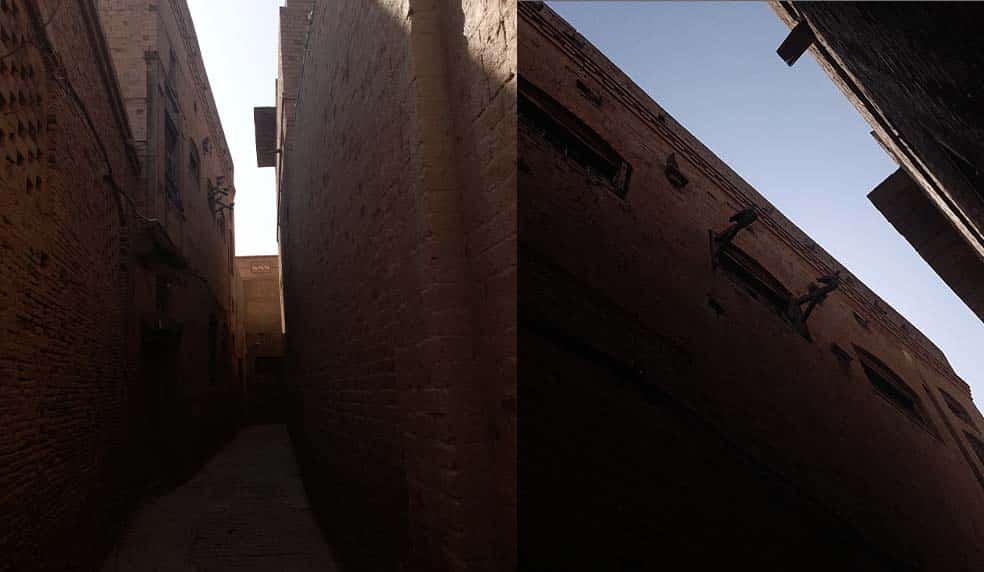
Photo Credits: Project Daastan
The View of Serenity
As we perambulate down the narrow streets to see the view, we suddenly feel the calmness in the atmosphere. The blue-tiled casing of the tomb and its very shape sets the shrine apart from others in the city. These blue tiles date back from the reign of Humayun; The Mughal Emperor said the Makhdum (Current Head) of the family. The graves of the lion and the snake, Shah Gardez brought with him from Afghanistan are directed with marks in the courtyard.
Custodianship of The Dome-Less Sanctuary Shah Gardez
Each successor of the custodian for the shrine is alternatively called ‘Yusuf Shah’ & ‘Raju Shah’. Interestingly enough, this fact is very uncommon for the shrine, nevertheless, the shrine itself is very uncommon. As per the aforementioned familial rule, the current custodian Syed Roshan Ali Gardezi goes by the title of ‘Yusuf Gardezi’. Raju Shah, the former custodian passed away in 2020, after 69 years of custodianship over the family.
The dome-less shrine is unlike all other shrines in the city, begging people for money and support. The shrine is free from all green boxes, asking for visitors aid for the shrine. Evidently, showcasing that the shrine is not under ‘Auqaf’, hence the compounds are free from green boxes yearning for aid. The walls of the shrine are free, and this sets the shrine apart from all others in the City of Saints. Shakir Hussain Shakir has also explained this fact in his book ‘Shah Yusuf Gardez’.
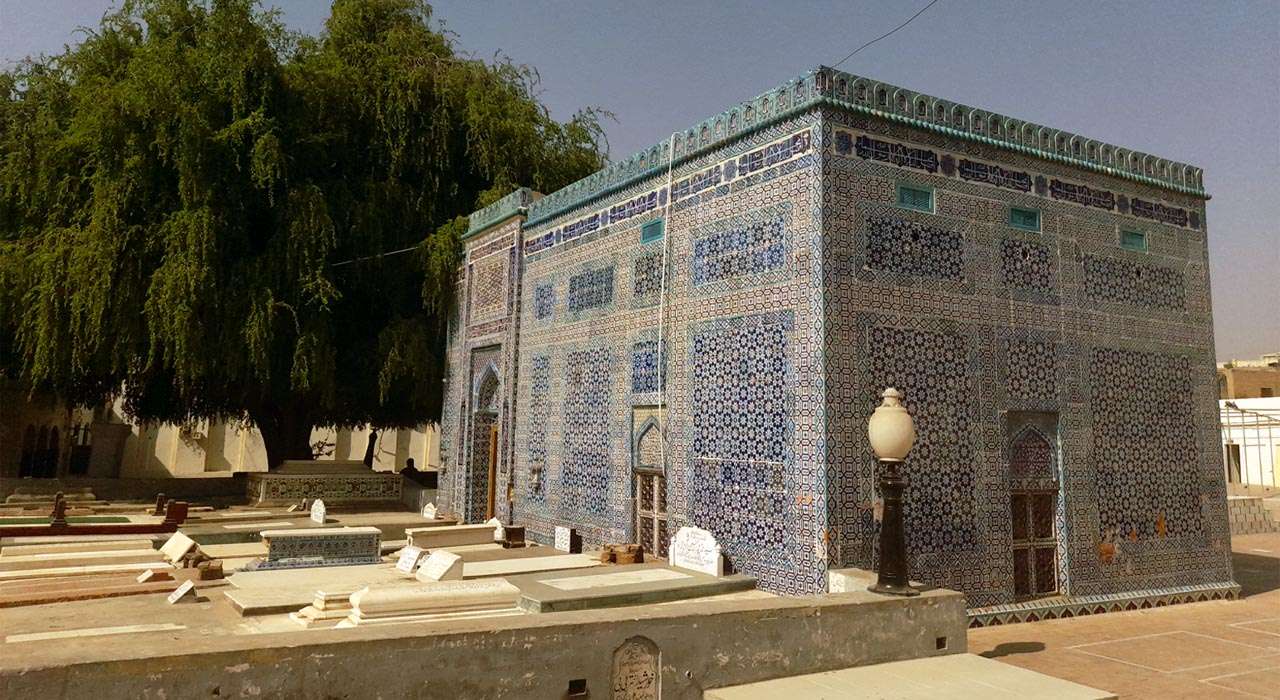
Photo Credits: Project Daastan
A whole mandir was discovered underground, during the digging at the time of reconstruction, said Makhdum’s wife. Furthermore, she was keen to tell us that the houses they have nearby in the Muhallah date long back. Gardezi’s have been thriving in the area and the localities while co-existing with other communities. Explaining the anciently settled family of the saint, near his shrine.
The Preeminent Story of Pigeons
Pigeons, the flock of pigeons that hover right above the sanctuary are not just a compelling natural view. These pigeons are the progeny of the same pigeons that travelled across borders with Yousaf Shah Gardez to Multan. The enchanted grounds of the shrine and the surroundings are not only hosting the Gardezi’s but the pigeons as well. As a matter of fact, these pigeons are paramount to the shrine, poking in and out of the shrine, hovering all over. Acting as the structure stands tall just for their benefit, these pigeons reside over the rooftops of Gardezi homes.
The Courtyard & Hujra of Shah Gardez Shrine
The courtyard is encased with floors lined with the graves of the Gardezi’s, buried overages. As we set foot in the courtyard, the white-tiled pathway leading to the Hujra marks the burial sites of his lion and snake. However, the courtyard has so much more than just the graves of the family of the saint; for an instance, the pigeons reflect natural peace. The unbroken family history stands proud right in the heart of Multan. Once you walk the courtyard, stride gradually for the angels might be paying obeisance therein.
The Hujra
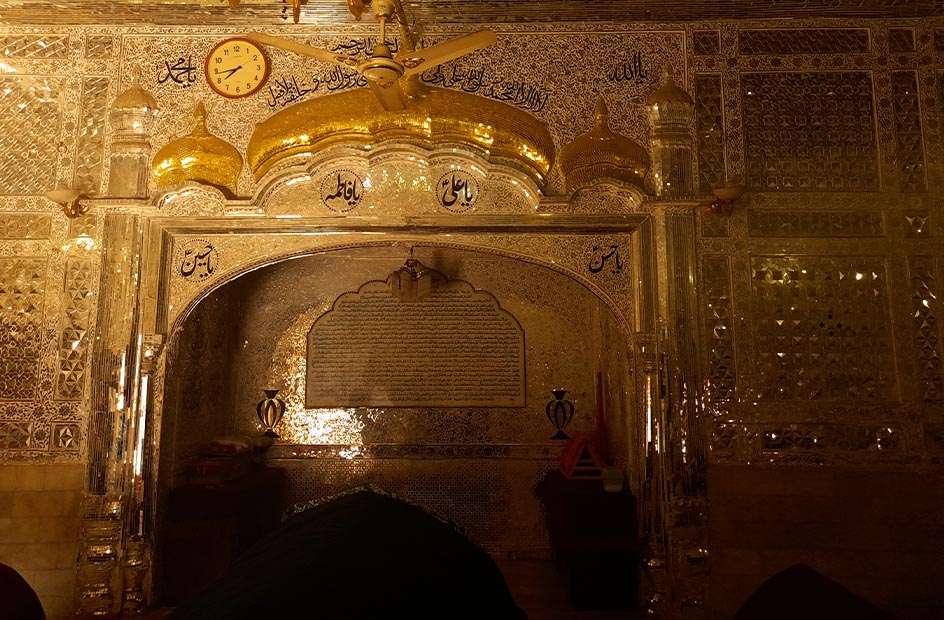
Photo Credits: Project Dastaan
The beauty and grandeur of the Shrine are portrayed perfectly once you stand right in front of it. With a delicate touch, feel those glazed tiles and Sheesham found on your fingertips. The shiny silvered walls with a hint of golden hue to make it embrace royalty is idyllic. The Hujra of Yusuf Shah Gardez, holds his burial site, a few descendants and his sons. The Kalma is inscribed above the Hujra followed by the names of Panjatan. Moreover, the shelves underneath host Quran, and a few other Islamic books.
The Footprint of Imam Ali (as)
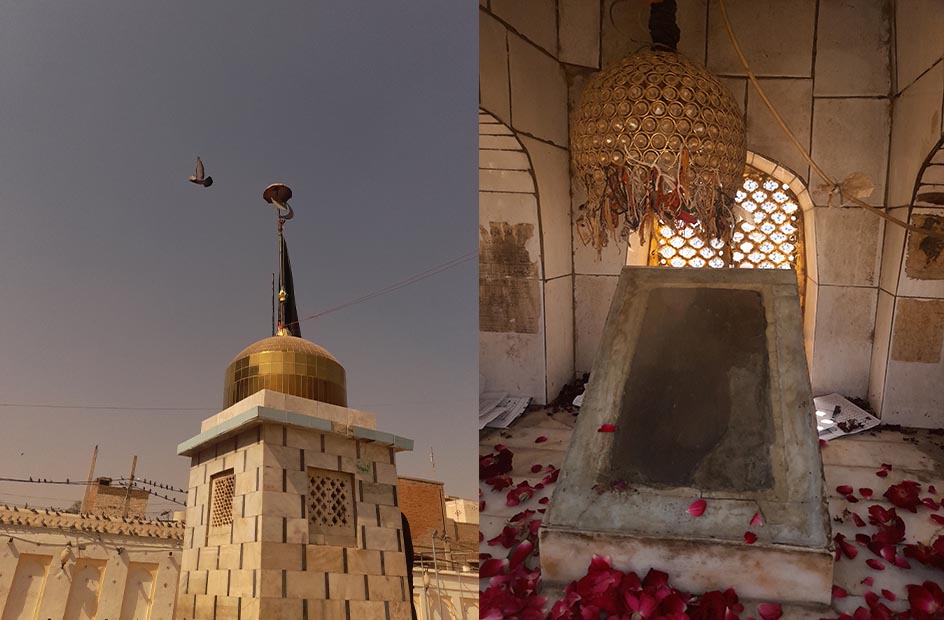
Photo Credits: Project Dastaan
Imam Ali (as) the husband of Hazrat Muhammad (saw) daughter, Bibi Fatima tuz Zahra (as), is one of the prominent figures in Islam after the last Prophet (saw). The shrine of Shah Gardez hosts another religiously unique spot, the footprint of Hazrat Ali (as). The Makhdum said, ‘Dozens of people come to pay homage to it daily’. Furthermore, he said that the saint brought it along when he travelled from Afghanistan to Multan. The backside of the shrine is home to the unique religious spot, the footprint of Hazrat Ali (as).
Intricate Details & Delicacy in Architecture
The intricate details of architectural masterpieces and the cultural heritage is not only observed outside the shrine. Once you enter the saint’s sanctuary, colours, textures and punctilious carvings are showcased. The light hue of the azure blue colour mixed with white glazed tiles, make it even more consistent and eye-catching. Moreover, the Quranic verses and the Durood Shareef engraved over the entrance is always compelling the visitors to recite. Illustrating the art of architecture and scrupulous attention to designs, the shrine is one a kind.
The Masjid & The Imambargah
The shrine in itself hosts both a Masjid with an exclusive architectural gleam reflecting old cultural designs and an Imambargah with 5 wooden doors, reflecting the same architectural touch of the Masjid. Both of the structures serve their own purpose within the walls of the shrine, making it one of the most religious centric landmarks in Pakistan.
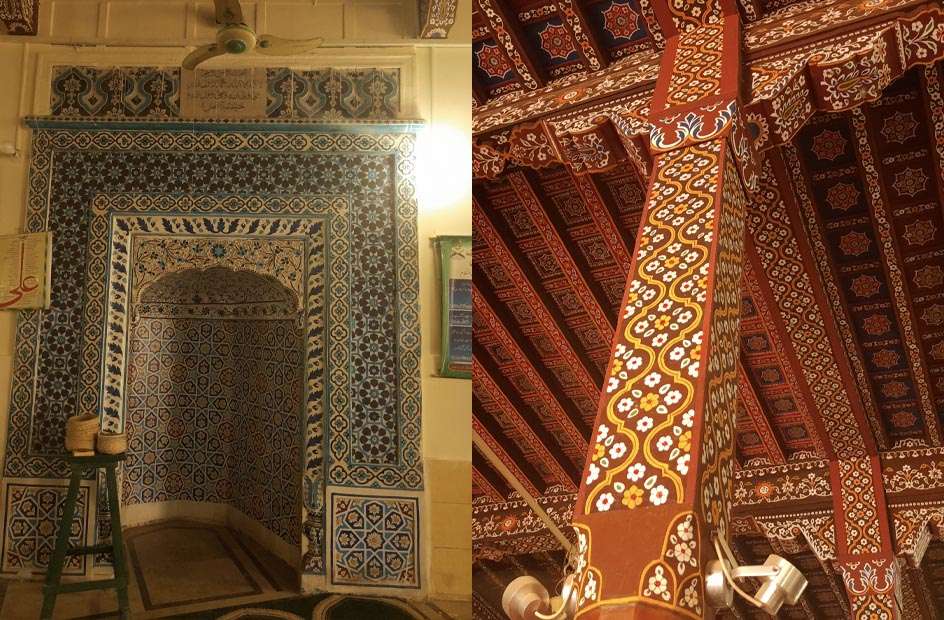
Photo Credits: Project Dastaan
Right in front of the sanctuary is the Mosque of the Shrine, made on the orders of Sher Shah Suri, This was told by late Hassan Nawaz Gardezi. Meanwhile, the woodwork of the Masjid reflects as ancient as the Mosque itself. Recently renovated and replicated towards their actual inception, these carvings and woodwork are one of a kind.
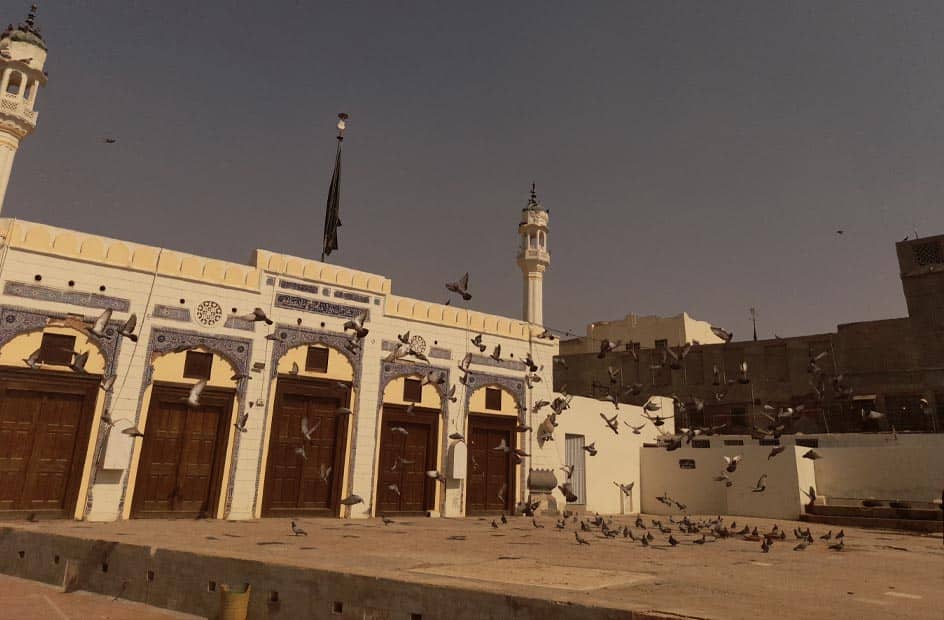
Photo Credits: Project Dastaan
The Imambargah at the shrine was first built in 1887, with a total area of 50×70 feet. Standing tall for more than a century, the ceilings and 5 huge gates have witnessed countless Majalis. The enamelled woodwork marks the beauty of the Imambargah. The month of Muharram marks the special preparations for the Majalis done therein.
The Makhdum House & Succession of Shah Gardez
The home of the direct descendants of Yousaf Shah is known as the Makhdum House in the area of the shrine. The same family members are the caretakers of the shrine, living at the same place forever. The Makhdums wife remarked the same thing as, ‘They have lived there all of their lives even if others relocate, they choose to stay. Moreover, he explained the architecture of the Makhdum house as well, remarking the pillars and the very walls of the home. The pillars of the home are said to be from Agra and installed in the same place as they are. Amalgamating perfection within the exterior of the home and the checkered floors, the pillars outshine the overall view. Just as intricate detailing should be, the walls are carved with equally beautiful heritage style windows.
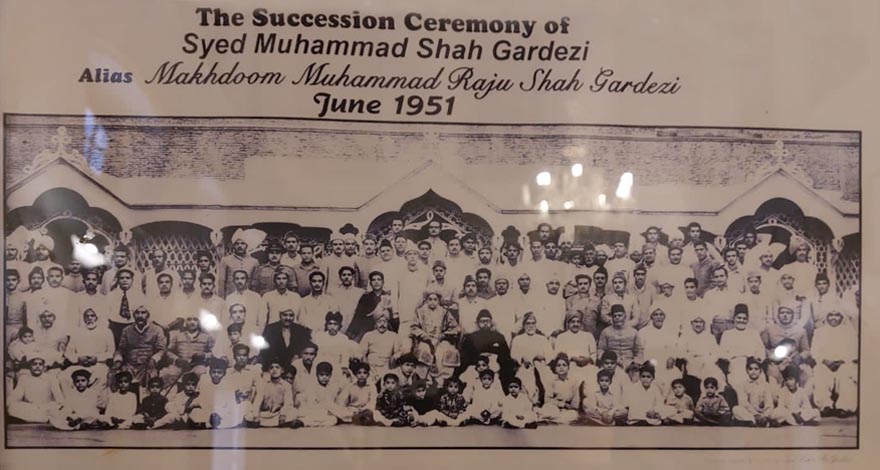
Photo Credits: Project Dastaan
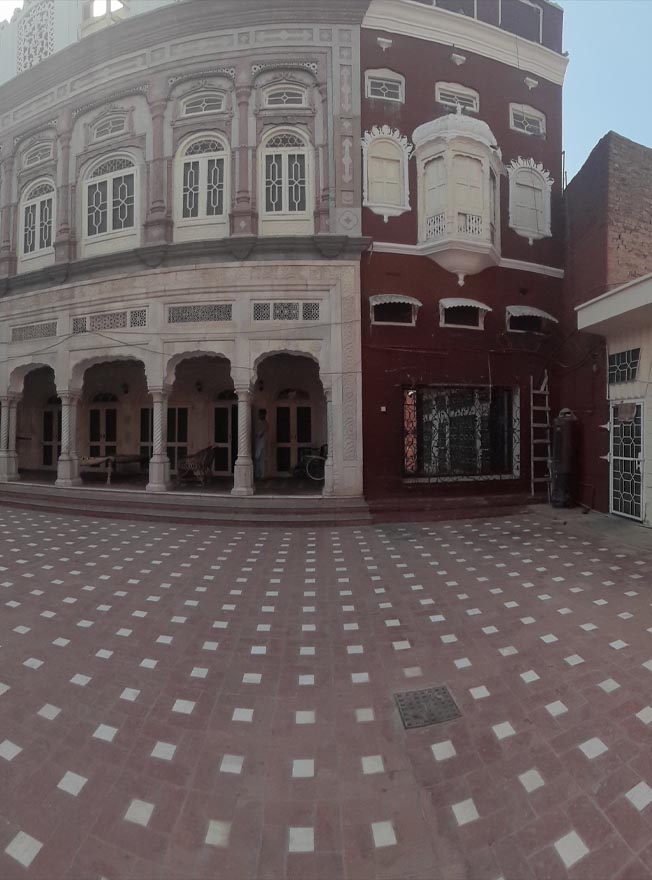
Photo Credits: Project Dastaan
Makhdum house is as old as the shrine itself, with the same old culturally rich architecture and design. Caretaking the shrine and the surroundings, the family pass on the headship within themselves. As a result, the coronation of the Sajjadanasheen is considered a grand event, and a new head is announced for the family. The event is grand enough to have a family photograph, each time the coronation takes place. As mentioned earlier that a new caretaker was announced for the shrine, in 2020. The previous head of the family and the caretaker Raju Shah commemorated the 50th year of his headship 19 years before he left the position for his son.
Nine Centuries of Perpetual History
The grounds of the shrine is home to a history of nine hundred years, perhaps a lifetime to ponder upon. The countless domes peaking all over the city have no root deeper than the dome-less sanctuary. The roots entangled with culture, heritage, art, religion and so much more, are the ones ruling the city of the saints. History of almost a millennium is all settled within a courtyard, a muhallah, a rectangular blue-tiled structure. Religious or historical talks are all set on the compounds of the shrine.